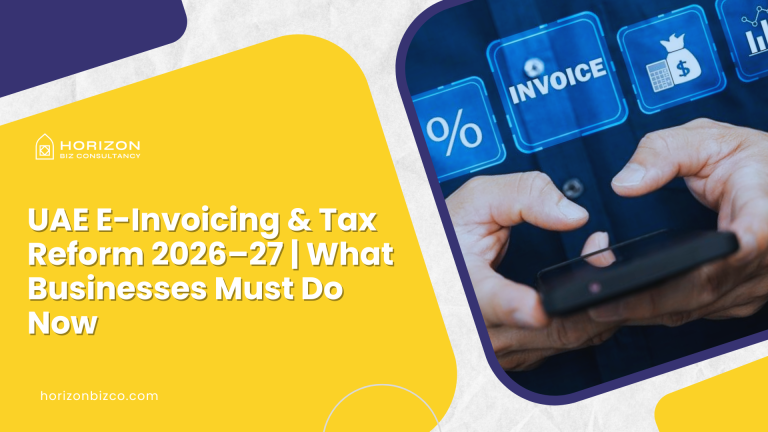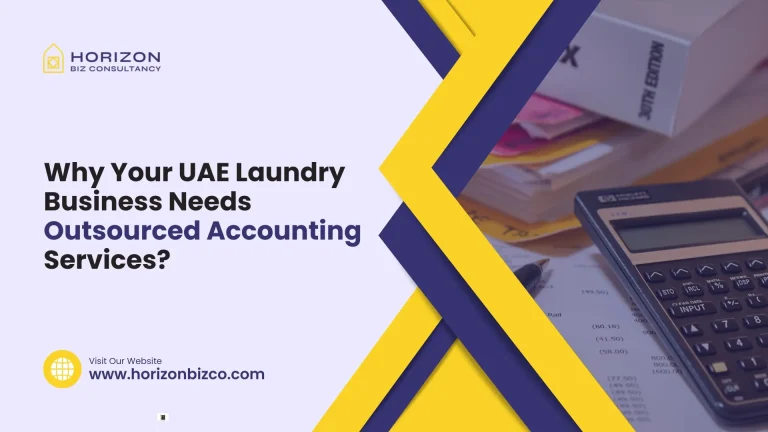Introduction
E-invoicing is not just another regulatory burden it marks a paradigm shift in how the UAE will enforce tax compliance, monitor transactions, and close gaps in VAT collections. As businesses transition into the new regime, the window to prepare is now.
Once you implement e-invoicing, the question becomes: What’s next? The tax landscape of the UAE is entering a phase of acceleration from corporate tax maturity, input tax apportionment, to real-time compliance, and data audits. In this blog, I’ll walk through what business and finance leaders in the UAE must anticipate and prepare for over 2026–2027 with actionable steps, caveats, and strategic insights.
The E-Invoicing Rollout: Timeline, Scope & Rules
Framework & Ministerial Decisions
On 29 September 2025, the UAE Ministry of Finance released two key ministerial decisions: Decision No. 243 of 2025 (Electronic Invoicing System) and Decision No. 244 of 2025 (Implementation Framework), defining the legal and operational landscape for e-invoicing.
These decisions clarify obligations on who must apply, when, how invoices and credit notes must be structured and transmitted, and exceptions for certain sectors.
Phased Rollout & Deadlines
The rollout is phased as follows:
- Pilot / voluntary adoption from 1 July 2026 for entities participating in the Taxpayer Working Group.
- Mandatory adoption for larger businesses (revenue ≥ AED 50 million):
• Appoint an Accredited Service Provider (ASP) by 31 July 2026
• Go live with e-invoicing by 1 January 2027 - For smaller businesses (revenue < AED 50 million):
• ASP appointment by 31 March 2027
• Go live by 1 July 2027 - Government entities: compliance by 1 October 2027
Notably, B2C transactions (business to consumer) are currently excluded from the mandatory scope, at least initially.
Technical & Operational Model
The UAE will adopt a 5-corner model (also called a decentralised continuous transaction control & exchange DCTCE) built on Peppol / PINT standards, where invoices are transmitted via Accredited Service Providers (ASPs) between supplier and buyer, and also reported to the FTA.
Invoices must be issued, structured, validated, and transmitted in approved schema formats (typically XML). Retail-style simplified invoices, image/PDF-only formats, or unstructured documents will not be acceptable under the e-invoice schema once fully live.
Invoices and credit notes must be reported to the Federal Tax Authority (FTA) in near real-time, with validations, acknowledgements, and status messages exchanged between corners of the system.
Failures or system downtime will have reporting obligations (e.g., notifying the FTA within two business days).
Changes in VAT Regulations to Support E-Invoicing
To support the transition, Cabinet Decision No. 100 of 2025 revised parts of the VAT Executive Regulations (Articles 59 and 60), especially around permissible invoice formats, zero-rated supplies, and administrative exceptions. Simplified invoices and prior reliefs will no longer be valid for entities under the e-invoice regime after rollout.
Given this context, businesses must revise invoice formats and eliminate reliance on simplified or exception-based tax invoices.
Strategic Impacts: What Changes When E-Invoicing is Live
Real-Time Visibility & Compliance
Once e-invoicing is fully operational, the FTA gains real-time or near-real-time access to transactional data. Errors, anomalies, or discrepancies can be flagged faster. This shifts the onus to businesses to maintain impeccable data quality: consistent master data, valid TRNs, accurate tax classifications, and systematic validations.
Reduced Scope for Invoice Manipulation & Tax Leakage
With structured digital invoices, the room to disguise or omit taxable value, mis-state VAT codes, or delay recognition shrinks. The FTA’s ability to cross-check and reconcile data rises. As Alvarez & Marsal notes, reliefs that previously allowed simplified formats or “no issuance” in certain scenarios will vanish post-e-invoicing.
Integration, Systems & ERP Transformation
Your legacy accounting, ERP, billing, or POS systems may need upgrades or modular add-ons to issue structured e-invoices, validate them, transmit through ASPs, parse acknowledgements, handle failures, and reconcile status messaging. Expect to invest in invoice engines, middleware, APIs, monitoring dashboards, and exception handling flows.
Process Redesign & Internal Controls
Manual approval flows, invoice batching, late issuance, or post-date adjustments will need governance protocols. With the technical enforcement layer, your internal controls must align with structured data constraints. Exception management, dispute resolution, reissuing, and credit note flows must also be coded to comply with schema and timeliness rules.
Data Analytics, Business Intelligence & Policy Insights
Structured invoices feed into richer data sets. Organisations can harness this for insights: customer behaviour, sector trends, tax optimisation, and forecasting. Moreover, the FTA and Ministry will use aggregated intelligence for policy interventions, compliance campaigns, and sectoral support.
Complementary Reforms: VAT, Tax & Group Structures
VAT Input-Tax Apportionment & Specified Recovery Percentage
In late 2025, the FTA updated guidance (VATGIT1) to clarify input tax apportionment rules and introduced the concept of a Specified Recovery Percentage (SRP), which, if approved, allows applying the previous year’s recovery percentage to the current residual VAT instead of recalculating from scratch.
This simplifies compliance, reduces volatility, and helps in budgeting VAT recoverability.
Corporate Tax Maturation & Group AFS Rules
As entities file corporate tax returns (first by 30 September 2025 for FY-end 31 Dec 2024), group structures require Aggregated Financial Statements (AFS) under Public Clarification CTP007. These rules affect intercompany eliminations, intra-group transactions, and uniform accounting treatments.
Moreover, the new Free Zone regime (Ministerial Decision 229 & 230 of 2025) refines which activities qualify for 0% tax benefits and introduces price reporting mechanisms. Businesses must confirm if their service or trading lines remain eligible.
Domestic Minimum Top-Up Tax (DMTT)
In line with the OECD’s Pillar Two, from FY starting 1 January 2025, large multinational enterprises (with consolidated revenue ≥ EUR 750 million) face a domestic minimum top-up tax in the UAE to ensure an effective tax rate of 15%. This shifts the UAE from a low-tax jurisdiction toward global alignment.
These tax reforms interlock with e-invoicing: clearer invoice trails feed into tax assessments, group audits, and top-up tax computations.
What Your Business Should Do Now
Gap Assessment & Impact Study
- Determine whether your entity falls into mandatory adoption waves (≥ AED 50 million revenue or smaller).
- List all invoicing use-cases (standard, credit notes, corrections, zero-rated, export, intercompany).
- Map your existing systems, data fields, flows, master data accuracy, exception cases, and downstream dependencies.
Engage Accredited Service Providers (ASPs) Early
Start evaluating ASPs (pre-approved by the Ministry) and negotiating SLAs, connectivity, failover arrangements, and monitoring frameworks. Many businesses will require more than six months to integrate and test. Deloitte warns that early planning is critical given the scale of change.
Systems & Middleware Upgrades
- Update ERP, billing, and accounting modules to produce structured e-invoice XML.
- Build or deploy middleware for message orchestration, validation, acknowledgements, and status handling.
- Design exception workflows (where invoices fail validation or get rejected).
- Integrate with ASP APIs and maintain logging/audit trails.
Strengthen Master Data & Data Governance
- Ensure TRNs, customer addresses, legal names, and tax classification codes are accurate and validated.
- Enforce data cleaning, de-duplication, and preventive validation at entry.
- Monitor change controls on customer and product master data.
Process & Control Redesign
- Embed mandatory timing constraints, e.g. issue invoice within 14 days of transaction, as required under MD 243.
- Define roles and responsibilities for who triggers invoice generation, who approves, who handles reissue, who handles status failures, and who monitors exceptions.
- Plan for downtime contingencies: backup modes, fallback procedures, notificati.ons to FTA for system outages.
Pilot, Test & Training
- If possible, participate in the voluntary pilot phase to test your flows under real conditions.
- Conduct internal dry runs, validate end-to-end exchange, parse acknowledgement flows, and monitor rejections.
- Train finance, billing, IT, audit, and operations teams on the new rules, schema constraints, failure management, and new KPIs.
Monitor Regulatory Updates & Clarifications
- The UAE FTA and Ministry will continue publishing public clarifications and guidance (as is already happening with VAT amendments, SRP, and new invoice rules).
- Keep legal and tax advisors close, subscribe to official channels, and update your compliance playbook regularly.
Risks & Pitfalls to Watch For
- Late or improper compliance: Missing the cut-off or underestimating implementation timelines can lead to non-compliance and penalties.
- Data inconsistencies: Mismatches in TRN, legal names, addresses, or tax codes will lead to rejections or audit flags.
- Vendor lock-in or ASP slowness: Choosing weak or inexperienced ASPs can slow your implementation.
- Legacy system constraints: If your invoicing system can’t output structured data, retrofitting might be costly or slow.
- Exception and reversal handling: Mistakes in credit notes, cancellations, or corrections must still conform to the schema and be reported in time.
- Audit trails & transparency: All status messages, logs, and transmissions must be stored and auditable in case of FTA reviews.
Conclusion
E-invoicing is not just compliance, it’s an inflection point for how business and tax truly merge in the UAE’s digital era. For organisations that prepare in 2025, the transition can become a catalyst for improving efficiency, reducing manual errors, unlocking analytics, and strengthening tax defensibility.
As the deadlines approach, the best-performing businesses will not simply avoid non-compliance. They will redesign processes, harness the data inflows, embed controls, and use e-invoicing as a foundation for next-level tax and finance transformation.
If you’d like me to convert this into a ready-to-publish SEO blog (with featured infographic, internal linking, and formatting for Pranav’s site), I can get that ready for you.
FAQ’s
If your annual revenue is AED 50 million or more, you must appoint an Accredited Service Provider by 31 July 2026 and comply by 1 January 2027. Smaller entities will follow in 2027 as per the phased schedule.
Not initially, business-to-consumer (B2C) transactions remain excluded from the mandatory scope under the current framework.
Simplified invoices, PDFs, scanned copies, or unstructured invoices will not be accepted. All tax invoices and credit notes must follow the prescribed structured XML schema under the e-invoicing standard.
Since the FTA gets real-time access to structured transaction data, it drastically reduces the possibility of omissions, disguised supplies, or misclassified VAT codes. The “room” for tax leakage narrows significantly.
You must notify the FTA within two business days of any system failure or outage. You’ll need fallback procedures, documentation, and a plan for recovery under regulatory rules.
Start with a gap & impact assessment; shortlist and engage Accredited Service Providers; upgrade systems and middleware; train your teams; participate in pilot tests; and monitor regulatory updates and clarifications regularly.





